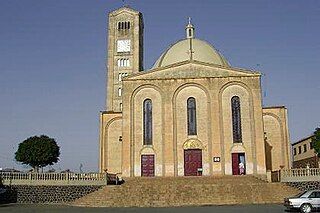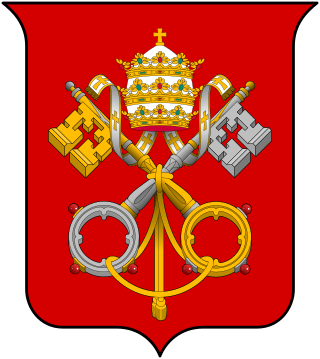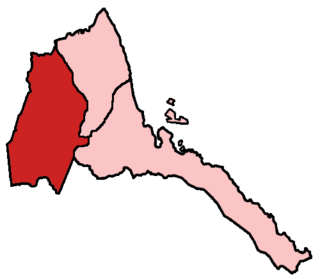
The Apostolic Vicariate of Asmara was a Roman Catholic missionary jurisdiction in Eritrea. Centered in Asmara it was at first the Apostolic Prefecture of Eritrea and then the Apostolic Vicariate of Eritrea.

The Apostolic Vicariate of Asmara was a Roman Catholic missionary jurisdiction in Eritrea. Centered in Asmara it was at first the Apostolic Prefecture of Eritrea and then the Apostolic Vicariate of Eritrea.
On 13 September 1894, the Holy See established the Apostolic Prefecture of Eritrea, then an Italian colony, with the decree Ut saluti animarum of the Congregation for the Propagation of the Faith. Its territory was taken from that of the Apostolic Vicariate of Abyssinia, which at that time had its headquarters in Keren, Eritrea, a town that became the first seat of the new Apostolic Prefecture of Eritrea. [1] On 7 February 1911, it was promoted to Apostolic Vicariate (with a titular bishop as ordinary).
The Apostolic Vicariate of Abyssinia was entrusted to missionaries of the Congregation of the Mission, who followed the lead of Saint Giustino de Jacobis, the founder of the mission, by using in the liturgy the local Ethiopic variant of the Alexandrian Rite in the Ge'ez language, not the Roman Rite in Latin. They were mainly French and, after Eritrea was declared an Italian colony in 1890, were expelled by the colonial authorities, who accused them of fomenting armed resistance. The Apostolic Prefecture of Eritrea was created for the Italian Capuchins, who replaced them. These promoted use of the Roman Rite, in view also of the arrival of Italian immigrants. Discontent among the Eritrean Catholics led to the sending in 1927 of the future cardinal Alexis Lépicier as an Apostolic Visitor to examine the situation. As a result, Father Kidanè-Maryam Cassà was appointed at first Pro-Vicar Apostolic for the Ethiopic-Rite Catholics and then, on 4 July 1930, bishop in charge of an independent Ordinariate of Eritrea. [2] [3] [4] [5] [6] The Eritrean Catholic Church is the continuation of this ordinariate and of the first Eritrean Catholic community.
The influx of Italians into Eritrea, especially in the 1930s, led to rapid expansion of the Vicariate, although it had thus in 1930 ceased to have responsibility for Ethiopic-Rite Catholics.
On 25 July 1959, when already in steep decline, it was renamed as the Apostolic Vicariate of Asmara, the capital of Eritrea.
Although at the beginning of the 1940s nearly 28% of the population of Italian Eritrea were Catholics, mostly Italians and of the Latin Church, [7] there was a pronounced fall in the number of Italians present after the end of the Second World War, when Eritrea was at first under British military administration. The British census of 1949 showed that Asmara, the capital, had only 17,183 Italians out of a total population of 127,579. The departure of Italians accelerated further when Eritrea came under Ethiopian authority at the end of 1950. The Vicariate, which previously had under its jurisdiction the great majority of the Catholics in Eritrea, became less important numerically than the growing ordinariate, which on 31 October 1951 was raised to the level of an exarchate (the Eastern equivalent of a Vicariate) under the name of the Apostolic Exarchate of Asmara, and on 28 February 1961 became an eparchy, the Eastern equivalent of a diocese. [8]
When the fourth and last bishop who held the post of Vicar Apostolic of Eritrea or Asmara retired on 2 June 1974, no successor was appointed and the administration of the Vicariate was entrusted to a Capuchin priest.
On 21 December 1995, after a quarter of a century of being without a bishop and being administered by a priest, the Vicariate was suppressed [9] at the same time as two new eparchies of the Ethiopian Catholic Church were formed from territory taken from the Eparchy of Asmara: Barentu [10] and Keren [11] (now suffragans of the Archeparchy of Asmara). With the suppression of the Vicariate, Eritrea was left with no Latin Church ordinary, and all Catholics in Eritrea were entrusted to the care of Eastern Catholic bishops, who since 19 January 2015 are prelates of the Eritrean Catholic Church.
The former importance of the Latin Vicariate is reflected in the impressive church dedicated to Our Lady of the Rosary [12] [13] [14] [15] [16] that was completed in 1923 as the principal church of the Apostolic Vicariate. Even after the demise of the Vicariate in 1995, it is still called "the cathedral". [12] [17]

Friar Luca Milesi, OFMCap (1971 – 1995.12.21); from 1995.12.21 first Eparch (Bishop) of the Eritrean Catholic Eparchy of Barentu

The Eritrean Catholic Church or Eritrean Eastern Catholic Church is a sui iuris (autonomous) Eastern Catholic church based in Eritrea. As a particular church of the Catholic Church, it is in full communion with the Holy See. It was established in 2015 when its territory was separated from the Ethiopian Catholic Church. The church is organized under a metropolitan bishop who exercises oversight of a number of suffragan dioceses. In its liturgical services, it uses the Alexandrian Rite in the Ge'ez language.

The Church of Our Lady of the Rosary, Asmara is a Catholic church built in the early 1920s in Asmara, when the city was the capital of Italian Eritrea. Often called "the cathedral", it is a large Lombard Romanesque style church in the centre of the city, built in 1923 to serve as the principal church of the Apostolic Vicariate of Eritrea.

The Ethiopian Catholic Church or Ethiopian Eastern Catholic Church is a sui iuris (autonomous) Eastern Catholic church that is based in Ethiopia. As a particular church of the Catholic Church, it is in full communion with the Holy See. Established in 1930, the church is organised under a metropolitan bishop who exercises oversight of a number suffragan dioceses. In its liturgical services, it uses the Alexandrian Rite in the Ge'ez language.

The Macedonian Greek Catholic Church or Macedonian Byzantine Catholic Church is a sui juris Eastern Catholic church in full union with the Catholic Church which uses the Macedonian language in the liturgy. The Macedonian Greek Catholic Church comprises a single eparchy, the Macedonian Catholic Eparchy of the Assumption of the Blessed Virgin Mary in Strumica-Skopje.

Eritrea as a country and the Eritrean community are multi-religious. Eritrea has two dominant religions, Christianity and Islam.

The Ethiopian Catholic Archeparchy of Addis Abeba, officially the Metropolitan sui iuris Archeparchy of Addis Abeba is the metropolitan see of the Ethiopian Catholic Church, a sui iuris metropolitan Eastern Catholic Church.

The Eparchy of Križevci is a Greek Catholic Church of Croatia and Serbia eparchy of the Catholic Church in Croatia, Slovenia, and Bosnia and Herzegovina. Its current eparch is Milan Stipić. The cathedra is in the Cathedral of the Holy Trinity, in the episcopal see of Križevci, Croatia.

The Diocese of Rome, also called the Vicariate of Rome, is a Latin diocese of the Catholic Church under the direct jurisdiction of the Pope, who is Bishop of Rome and hence the supreme pontiff and head of the worldwide Catholic Church. As the Holy See, the papacy is a sovereign entity with diplomatic relations, and civil jurisdiction over the Vatican City State located geographically within Rome. The Diocese of Rome is the metropolitan diocese of the province of Rome, an ecclesiastical province in Italy. According to Catholic tradition, the first bishop of Rome was Saint Peter in the first century. The incumbent since 13 March 2013 is Pope Francis.

The Apostolic Vicariate of Anatolia is a Roman Catholic Latin apostolic vicariate in the eastern half of Anatolia.

The Apostolic Vicariate of Harar is a Roman Catholic apostolic vicariate located in the city of Harar in Ethiopia.
François Abraha was an Ethiopian bishop of the Ethiopian Catholic Church who served as the bishop of the Eparchy of Asmara from 1961 to 1984.

The Eritrean Catholic Archeparchy of Asmara, officially the Archeparchy of Asmara, more informally Asmara of the Eritreans, is the metropolitan see of the Eritrean Catholic Church, a sui iuris Eastern Catholic Church whose territory corresponds to that of the State of Eritrea in the Horn of Africa. It depends on the Roman Congregation for the Oriental Churches.

The Eritrean Catholic Eparchy of Barentu is a Catholic eparchy located in the town of Barentu in Eritrea. It is a part of the ecclesiastical province of Asmara.

The Eritrean Catholic Eparchy of Keren is a Roman Catholic eparchy centred in the city of Keren in Eritrea. It is a suffragan of the Archeparchy of Asmara, and a constituent eparchy of the Eritrean Catholic Church.

The Apostolic Vicariate of Aleppo is an apostolic vicariate and is immediately subject to the Holy See and its missionary Dicastery for the Eastern Churches.
The Apostolic Vicariate of Hosanna is a Catholic pre-diocesan missionary jurisdiction of the Roman Catholic Church in Ethiopia.

Kidane Mehret Cathedral is a Catholic church located on Adi Quala Street, Asmara, Eritrea. The cathedral belongs to Eritrean Catholic Archeparchy of Asmara.
Evangelista Latino Enrico Vanni OFMCap was an Italian Bishop and missionary who served as the Apostolic Vicar of Arabia from 1916 to 1927 and the Archbishop of Agra from 1937 to 1955. He also served as the Titular Archbishop of Tenedus from 1916 to 1955 and Titular bishop of Bizya from 1955 until his death.